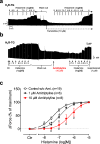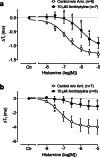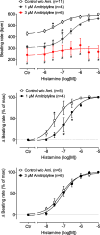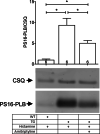Amitriptyline functionally antagonizes cardiac H2 histamine receptors in transgenic mice and human atria
- PMID: 33625558
- PMCID: PMC8208937
- DOI: 10.1007/s00210-021-02065-7
Amitriptyline functionally antagonizes cardiac H2 histamine receptors in transgenic mice and human atria
Abstract
We have previously shown that histamine (2-(1H-imidazol-4-yl)ethanamine) exerted concentration-dependent positive inotropic effects (PIE) or positive chronotropic effects (PCE) on isolated left and right atria, respectively, of transgenic (H2R-TG) mice that overexpress the human H2 histamine receptor (H2R) in the heart; however, the effects were not seen in their wild-type (WT) littermates. Amitriptyline, which is still a highly prescribed antidepressant drug, was reported to act as antagonist on H2Rs. Here, we wanted to determine whether the histamine effects in H2R-TG were antagonized by amitriptyline. Contractile studies were performed on isolated left and right atrial preparations, isolated perfused hearts from H2R-TG and WT mice and human atrial preparations. Amitriptyline shifted the concentration-dependent PIE of histamine (1 nM-10 μM) to higher concentrations (rightward shift) in left atrial preparations from H2R-TG. Similarly, in isolated perfused hearts from H2R-TG and WT mice, histamine increased the contractile parameters and the phosphorylation state of phospholamban (PLB) at serine 16 in the H2R-TG mice, but not in the WT mice. However, the increases in contractility and PLB phosphorylation were attenuated by the addition of amitriptyline in perfused hearts from H2R-TG. In isolated electrically stimulated human atria, the PIE of histamine that was applied in increasing concentrations from 1 nM to 10 μM was reduced by 10-μM amitriptyline. In summary, we present functional evidence that amitriptyline also acts as an antagonist of contractility at H2Rs in H2R-TG mouse hearts and in the human heart which might in part explain the side effects of amitriptyline.
Keywords: Amitriptyline; Chronotropy; H2-histamine receptor; Histamine; Human atrium; Inotropy; Phospholamban phosphorylation; Transgenic mice.
Conflict of interest statement
The authors declare that they have no conflicts of interest.
Figures







Similar articles
-
Ergometrine stimulates histamine H2 receptors in the isolated human atrium.Naunyn Schmiedebergs Arch Pharmacol. 2023 Dec;396(12):3809-3822. doi: 10.1007/s00210-023-02573-8. Epub 2023 Jun 24. Naunyn Schmiedebergs Arch Pharmacol. 2023. PMID: 37354215 Free PMC article.
-
Cardiac Effects of Novel Histamine H2 Receptor Agonists.J Pharmacol Exp Ther. 2021 Nov;379(3):223-234. doi: 10.1124/jpet.121.000822. Epub 2021 Sep 17. J Pharmacol Exp Ther. 2021. PMID: 34535565
-
Phosphodiesterases 2, 3 and 4 can decrease cardiac effects of H2-histamine-receptor activation in isolated atria of transgenic mice.Naunyn Schmiedebergs Arch Pharmacol. 2021 Jun;394(6):1215-1229. doi: 10.1007/s00210-021-02052-y. Epub 2021 Feb 12. Naunyn Schmiedebergs Arch Pharmacol. 2021. PMID: 33576869 Free PMC article.
-
H2 antihistamines: May be useful for combination therapies in cancer?Biochem Pharmacol. 2024 May;223:116164. doi: 10.1016/j.bcp.2024.116164. Epub 2024 Mar 24. Biochem Pharmacol. 2024. PMID: 38531422 Review.
-
[Histamine effects on the heart with special reference to cardiac side effects of H2 receptor antagonists].Klin Wochenschr. 1989 Aug 1;67(15):743-55. doi: 10.1007/BF01745343. Klin Wochenschr. 1989. PMID: 2570178 Review. German.
Cited by
-
Effects of hallucinogenic drugs on the human heart.Front Pharmacol. 2024 Feb 2;15:1334218. doi: 10.3389/fphar.2024.1334218. eCollection 2024. Front Pharmacol. 2024. PMID: 38370480 Free PMC article. Review.
-
Ergotamine Stimulates Human 5-HT4-Serotonin Receptors and Human H2-Histamine Receptors in the Heart.Int J Mol Sci. 2023 Mar 1;24(5):4749. doi: 10.3390/ijms24054749. Int J Mol Sci. 2023. PMID: 36902177 Free PMC article.
-
Stimulation of histamine H1-receptors produces a positive inotropic effect in the human atrium.Naunyn Schmiedebergs Arch Pharmacol. 2025 Jun;398(6):7235-7250. doi: 10.1007/s00210-024-03735-y. Epub 2024 Dec 27. Naunyn Schmiedebergs Arch Pharmacol. 2025. PMID: 39729205 Free PMC article.
-
Ergometrine stimulates histamine H2 receptors in the isolated human atrium.Naunyn Schmiedebergs Arch Pharmacol. 2023 Dec;396(12):3809-3822. doi: 10.1007/s00210-023-02573-8. Epub 2023 Jun 24. Naunyn Schmiedebergs Arch Pharmacol. 2023. PMID: 37354215 Free PMC article.
-
Possible Association between the Use of Proton Pump Inhibitors and H2 Receptor Antagonists, and Esophageal Cancer: A Nested Case-Control Study Using a Korean National Health Screening Cohort.Pharmaceuticals (Basel). 2022 Apr 22;15(5):517. doi: 10.3390/ph15050517. Pharmaceuticals (Basel). 2022. PMID: 35631344 Free PMC article.
References
-
- Angus JA, Black JW. Pharmacological assay of cardiac H2-receptor blockade by amitriptyline and lysergic acid diethylamide. Circ Res. 1980;46(6 Pt 2):I64–I69. - PubMed
-
- Baumann G, Felix SB, Riess G, Loher U, Ludwig L, Blömer H. Effective stimulation of cardiac contractility and myocardial metabolism by impromidine and dimaprit--two new H2-agonistic compounds--in the surviving, catecholamine-insensitive myocardium after coronary occlusion. J Cardiovasc Pharmacol. 1982;4(4):542–553. doi: 10.1097/00005344-198207000-00004. - DOI - PubMed
-
- Baumann G, Mercader D, Busch U, Felix SB, Loher U, Ludwig L, Sebening H, Heidecke CD, Hagl S, Sebening F, Blömer H. Effects of the H2-receptor agonist impromidine in human myocardium from patients with heart failure due to mitral and aortic valve disease. J Cardiovasc Pharmacol. 1983;5(4):618–625. doi: 10.1097/00005344-198307000-00017. - DOI - PubMed
MeSH terms
Substances
LinkOut - more resources
Full Text Sources
Other Literature Sources
Miscellaneous

